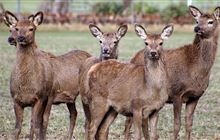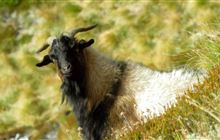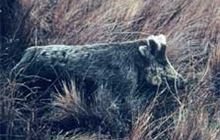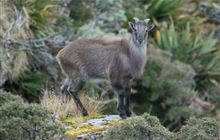Wild Animals Management Programme
Introduction
Our Wild Animals Management Programme manages wild goats, deer, pigs, tahr, and chamois to protect native plants and habitats.Wild goats, deer, pigs, tahr, and chamois eat and damage native plants and habitats – in some places, they threaten how ecosystems function.
Introduced wild animals can:
- change the type and number of plants present,
- change soil qualities
- prevent forest regeneration.
Managing wild animals to reverse these effects will help protect native species and increase forests' health and resilience in dealing with climate change.
DOC monitors sites on public conservation land across the country for the faecal pellets (droppings) of deer, goats, and sheep, tahr, and chamois. This provides our team with an indicator of wild animal numbers. From 2013 to 2022, the number of faecal pellets almost doubled, indicating growth in wild animal populations.
Methods used to manage wild animals
Hunting/shooting
Aerial and ground hunting/shooting are the most common methods used for wild animal management. DOC uses a combination of professional hunters and staff with highly trained indicator or bailing dogs for locating animals for removal. Other methods used are trapping and mustering.
Biosecurity work
Biosecurity measures are used to prevent further introductions, spread of introduced wild animals and remove incursions. Biosecurity work could include fencing, compliance checks for deer farms, or carrying out eradication checks on land that is meant to be free from wild animals.
Research and monitoring
Research and monitoring are used to understand population numbers and impact on plants and ecosystems. They are important tools in wild animal management and used to inform where management occurs.
DOC’s work
DOC is responsible for:
- managing populations of wild goats, deer, pigs, and tahr at priority DOC-managed conservation sites
- taking a leadership role across all land to ensure concerted action against the damaging effects of wild animals on vegetation, soils, waters, and wildlife.
Our Wild Animals Management Programme aims to maintain or achieve wild-animal-free areas, prevent the spread of wild animals into new areas, manage their numbers elsewhere to reduce pressure on native plants and habitats.
Managing populations
Management operations at place for deer, goats, pigs and tahr can differ. DOC’s management approach and priorities are based on factors including:
- the biodiversity value of a site (example: the amount and types of native plants)
- vegetation impacts
- other threats and pressures at a site (example: the presence of possums or the risk of wild animals reinvading from neighbouring land)
- feasibility of carrying out operations (example: what is the terrain like, and how much might an operation cost)
- other conservation activities happening at site.
Wild animal management map – 2023/24 financial year (JPG, 94K)
Coordinating action
Managing wild animals is broader than DOC because they are present across public and private land and there are a range of groups with interests in how they are managed.
DOC has set up a Wild Animal Management National Coordination Group to help coordinate action across the sector. The group is a forum to prioritise and co-ordinate actions for effective wild animal management. There is a diverse range of organisations involved including the conservation sector, hunting sector, Māori organisations, primary industry groups, as well as research institutions.
Related links
Programme summary 2022-23 (PDF, 2,471K)
Subscribe to our e-newsletter and stay up-to-date.
Getting involved
DOC cannot do this work alone. If we all play a part to protect Aotearoa New Zealand’s native plants and habitats, the difference will be even greater and longer lasting. There are lots of ways that you can help.
Report sightings in wild-animal-free areas
If you encounter a wild animal in an area that DOC is working to keep wild-animal-free, report it to wildanimalmanagement@doc.govt.nz.
If you are in Northland and spot a wild deer, call the 24/7 Deer Hotline on 0800 Find Deer (0800 346 333).
Wild animal free areas include:
- Deer free Northland and Coromandel
- Goat free Mount Taranaki
- Goat free forests, including Raukūmara, Whirinaki, Kaweka, and Te Urewera.
- Farewell Spit in Golden Bay (has some pigs)
- Cleddau Valley in Fiordland
- Islands including Maud Island/Blumine Island in Marlborough, and Secretary, Anchor, and Indian Island in Fiordland.
Take part in a hunt
There is an opportunity to align hunting efforts with conservation. Hunting is a valued activity in New Zealand, and people hunt deer, goats, and pigs for food, business, and recreation. To find a hunting area near you, and for more information, visit doc.govt.nz/hunting.
Tell DOC about the biodiversity and threats you see
Hunters often access New Zealand’s remote back country and wilderness areas. Our DOC offices get valuable information about nature and biodiversity from hunters for example, about sightings of whio / blue duck or reports about invasive weeds. Contact a DOC office with your observations and reports and help safeguard Aotearoa New Zealand’s unique biodiversity.
Manage wild animal numbers on your land
If you are a landowner, you can control wild animal numbers by contracting hunting professionals or giving access to recreational hunters who can be contacted through a local hunting club and collaborate with other landowners or organisations near you. Wild animals do not respect property boundaries, work with your neighbours to increase the efficacy of your management.
If you are a deer farmer, please make sure you comply with the appropriate deer fencing and permit regulations for your area.
Contribute to other conservation initiatives
To get involved with community conservation groups working around the country. Find a conservation group near you.
Get advice from DOC’s Wild Animals Management Team
DOC’s team can give you advice on methods, best practice, safety, legislation and regulations. They can also connect you with other groups or organisations in your region. Email the team at wildanimalmanagement@doc.govt.nz.
Te Ara Ki Mua framework
Te Ara Ki Mua framework is a national framework designed to guide the collaborative effort needed to reduce browsing pressure on our environment from wild deer, pigs, goats, tahr and chamois. It describes actions to achieve the goals of Te Mana o Te Taiao Aotearoa New Zealand Biodiversity Strategy.




